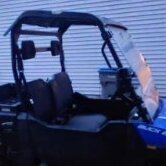Drive line question
-
Similar Topics
-
By felo72
Hello all. I purchased a brand new Massimo Buck 250 EFI in June for our farm and I've had the parking brake fail on me twice. I have approximately 250 miles on the vehicle. The first time was less than a month after receiving the UTV. We all of a sudden lost brake pressure and it would not start. I tracked the issue back to the parking brake. Upon removing the chain cover, I noticed the brake pad was missing and the caliper piston was touching the rotor. I found a set of brake pads online and replaced them myself. It's worked for several months and just happened again. Seems like a design flaw. I'm reaching out to see if there's an upgrade option available, or if I should replace the entire caliper with the brake pads? Thanks in advance for any advise.
I submitted a warranty claim, so I'll keep this updated with what Massimo replies.
When I replaced the brake pads the first time, back in July, my Son made a video on YouTube to show the unique caliper design. Here's a link if you wanted to check it out:
-
By Fishing Wiskers
Top speed is 30mph on flat grass ground. but it will not go up minor hills forward or reverse without a runing start. If you start at the bottom of the hill machine will stop about 1/2 way up. I have the engine cover off and you can see the outside of the drive clutch will stop spining., and the engine does bogg down some. Dosent matter if engine is cold or warmed up. Seat belts are connected. Fuel is clean
I am the 5th shop to look at it and different shops have replaced the fuel pump, injector, ign coil, wet clutch,
I am not sure how to check for codes with this machine, can anyone teall me how to do it?
Compression with hot eng is 145, valves adjusted to .005 with a cold engine. Dash shows 426 hours
I am not convinced it's an engine problem
-
By Chas
When traveling in the 40 mph range and throttle is released machine starts surging instead of a gradual slow down any help would be appreciated as dealer is clueless
-
By Jim Kessell
2005 American Landmaster
EH65 Subaru Robins
spits fuel from breather hose into the air cleaner and then down into carb. What’s causing this ??
-
By Michigan sport.
I'm sure many of you are aware of Michigan's emergency brake requirement. I'm wondering if anyone has a good solution.
Beyond paying the few fab places $$$$.. I'm curious is there another rear caliper with e brake style that would interchange with slight mods to the Maverick sport rear mounting bracket?
-









Recommended Posts
Join the conversation
You can post now and register later. If you have an account, sign in now to post with your account.